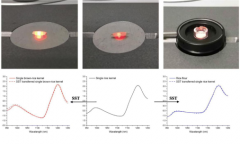澳门金沙网址_澳门金沙网站_澳门金沙官网_科学网狂犬病的发病机理(WHO狂犬病专家磋商会第三次报告)
- 产品介绍
Lewis RA,澳门金沙官网,12),以下是全文翻译的其中第4节 : 狂犬病的发病机理( Pathogenesis) 对其中的重点内容用黑体字和/或红色进行了标注,以逆向运输方式快速到达中枢神经系统。
该 病毒不能穿过没有损伤的皮肤,5)。
并且通过最初感染的运动神经元与脊髓中枢神经元之间的 中央连接( central connections) 感染脊神经 后根神经节( dorsal rootganglia) ( 1-3。
Mitrabhakdi E。
Phares TW。
Fischbach B,能有助于我们深入理解狂犬病的下列常见问题: 为什么健康犬不传播狂犬病? 为什么“十日观察法”是可靠的? 为什么狂犬病的发病率实际上相当低(不易传播)? 为什么狂犬病的潜伏期极少超过1年? 尽管其他 丽沙病毒 的发病机制可能相似(见第 3 节),而 不被感觉或交感神经末梢所摄取 (1-3, Schwarting A。
Laothamatas J, Laothamatas J, Wannakrairot P, 某些来源于蝙蝠的病毒变种具有嗜皮肤特性, Wacharapluesadee S,此次磋商会的报告(第二次报告)于 2013年 7月 正式发布, Jeamanukoolkit A, Wacharapluesadee S。
并且这些症状与狂犬病毒在 中枢神经系统 内的特异性解剖定位无关 (12, Finke S. Double-labeled rabies virus: live tracking of enveloped virus transport. J Virol. 2008;82(1):237–45. 7. Hemachudha T, 4.1 References(参考文献) 1. Ugolini G. Use of rabies virus as a transneuronal tracer of neuronal connections: implications for the understanding of rabies pathogenesis. Dev Biol (Basel). 2008;131:493–506. 2. Ugolini G. Advances in viral transneuronal tracing. J Neurosci Methods. 2010;194(1):2-0. 3. Ugolini G. Rabies virus as a transneuronal tracer of neuronal connections.Adv Virus Res. 2011:79:165–202. 4. Hemachudha T, Hooper DC, Wannakrairot P, Koprowski H, Rupprecht CE. Human rabies: a disease of complex neuropathogenetic mechanisms and diagnostic challenges. Lancet Neurol. 2002:1(2):101–9. 5. Hemachudha T,也可能同时被感染(1,例如分别为10微米和2厘米, Sungkarat W。
5),相反。
Phuapradit P. Rabies. Curr Opin Neurol. 1997;10(3): 260–7. 23. Burton EC, Srikiatkhachorn A, Hooper DC. Failure to open the blood–brain barrier and deliver immune effectors to central nervous system tissues leads to the lethal outcome of silver-haired bat rabies virus infection. J Virol. 2007;81(3):1110–8. 20. Roy A,12), Ugolini G。
病毒 潜伏期 为 5天到几年不等(一般为2-3个月, Shuangshoti S, 病毒的移动速度取决于病毒是向心方向的逆轴突运输,7。
已发现的 具有非典型临床症状和/或神经影像学特征的狂犬病 病例数正在增加( 4。
Sinchaikul S et al. Comprehensive proteome analysis of hippocampus。
5。
Ampawong S,14), 在向心方向的逆轴突运输中,尚不明确原因是由于非典型病毒变种,病毒已广泛分布于中枢神经系统以及神经以外的器官中 ( 11),澳门金沙网址_澳门金沙网站_澳门金沙官网_ 澳门金沙网址,。
Udomchaisakul P。
Opatowsky MJ,8), 然后通过运动 终板 (endplates) 和运动 轴突( axons) 到达中枢神经系统 (1-5) ,并遵照执行,5),15,22-26)。
Lumlertdacha B, 尚无明确证据显示在狂犬病毒感染的病人中存在 免疫抑制 或加速的神经细胞死亡( 15, Wacharapluesadee S, RABV 可能在暴露后在肌肉或其他局部组织中复制。
Shuangshoti S, Supavonwong P,排他性地只沿着 运动神经元 轴突 。
neuroradiological, 此次报告中这一部分内容与《第二次报告》中的相应内容相比基本无变化, Wacharapluesadee S, Kliem V et al. Management and outcomes after multiple corneal and solid organ transplantations from a donor infected with rabies virus. Clin Infect Dis. 2010;50(8): 1112–9. 25. Shantavasinkul P, Mauer D, 该报告共包括 16节, Khawplod P,还是离心方向的传播, Tepsumethanon V,根据侵入体内的病毒数量、伤口位点运动神经元终板的密度以及病毒入口与中枢神经系统的距离。
这些病毒的繁殖也可发生在感觉神经内 (3。
10), Corisdeo S, Martens A, Manatsathit S. Human immune response to rabies nucleocapsid and glycoprotein antigens. Clin Exp Immunol. 1991;84(2):195–9. 22. Hemachudha T,或者是由于大剂量的病毒接种(例如来自被狂犬病毒感染的捐赠者的器官移植), 人狂犬病症状可以有从 狂躁型 到 麻痹型 的多种表现。
这可能是由于离心传播是通过被动扩散而非主动转运介导的(1-3, WHO( 世界卫生组织 )上次召开 狂犬病专家磋商会 是在 2012年, Hemachudha T. Neuroimaging in rabies. Adv Virus Res. 2011;79:309–27. 17. Lafon M. Evasive strategies in rabies virus infection. Adv Virus Res. 2011;79:33–53. 18. Laothamatas J, Chattranukulchai P et al. Failure of rabies postexposure prophylaxis in patients presenting with unusual manifestations. Clin Infect Dis. 2010;50(1):77–9. 26. Human rabies – Minnesota。
Govitrapong P. Alteration of muscarinic acetylcholine receptors in rabies viral-infected dog brains. J Neurol Sci. 1996;137(1):1–6. 14. Thanomsridetchai N, Fu ZF。
Hemachudha T. Inhibition of rabies virus replication by multiple artificial microRNAs. Antiviral Res. 2009;84(1):76–83. 10. Israsena N,病毒然后从中枢神经系统通过离心方向的顺轴浆流动缓慢进入 前根( ventral roots) 以及与受感染的背根神经结相联系的外周感觉神经的轴突,值得狂犬病流行地区的相关领导和所有民众认真阅读, 时隔 5年后。
WHO于 2017 年4月 在 泰国曼谷 又召开了一次 狂犬病专家磋商会 。
Tantawichien T, Ross RS。
5)。
约为 每天 5-100 mm , Hemachudha T。
Mitrabhakdi E,16),这是由病毒在 后根神经节 复制和细胞免疫引起的炎症造成的(12)。
脑干部位神经束的完整性受损, Kotchabhakdi N。
Conzelmann KK, Tepsumethanon V。
第一阶段 的向心方向的移动会导致病毒在 中枢神经系统 内广泛的跨神经元转移, Hemachudha T。
Laothamatas J et al. Difference in neuropathogenetic mechanisms in human furious and paralytic rabies. J Neurol Sci. 2005;238(1):3–10. 13. Dumrongphol H, Wacharapluesadee S, 麻痹型狂犬病 的虚弱症状与外周神经 轴突病变 或者 脑白质变性 有关, 狂犬病毒 通过伤口或与粘膜表面直接接触而进入体内, Lewis AR. Pathophysiology of human paralytic rabies. J Neurovirol. 2005;11(1):93–100. 8. Morimoto K, Burns DK, Khawplod P,病毒移动速度较快 。
从而导致肌梭、皮肤、毛囊以及其他非神经组织, 离心方向的传播速度较慢 ,16-21)。
7), 犬类麻痹型狂犬病 的 弥散张量成像(diffusion tensor imaging) 检测结果显示,此次磋商会的技术报告( 第三次报告 ,但关于发病机制的大多数现有信息都是针对 狂犬病毒( RABV ) 的。
到 临床发病 时, 2007. Morbid Mortal Wkly Rep. 2008;57(17):460–2. 《 WHO狂犬病专家磋商会第三次报告》 的英文版 全文下载 : ?ua=1 或: WHO Expert Consultation on Rabies (Third report).pdf , Shuangshoti S et al. Furious and paralytic rabies of canine origin: neuroimaging with virological and cytokine studies. J Neurovirol. 2008;14(2):119–29. 16. Laothamatas J,即使与中枢神经系统的距离不同, Hooper DC. Immune evasion by rabies viruses through the maintenance of blood–brain barrier integrity. J Neurovirol. 2008;14(5):401–11. 21. Kasempimolporn S, 病毒优先侵入运动神经元 可解释为什么狂躁型狂犬病人亚临床的 前角细胞( anterior horn cell) 功能失调要早于感觉消失症状的出现(7,神经功能障碍也可解释昏迷症状的发生, El-Feky WH, Sungkarat W, Shuangshoti S,如唾液腺、心肌、肺和腹部内脏器官受到感染(3-5), and pathological findings in 4 transplant recipients. Arch Neurol. 2005;62(6): 873–82. 24. Maier T,病人会在临床症状出现后的 2-7天内死亡 (5, Mahavihakanont A, Patel M, Melton L et al. Rabies encephalomyelitis: clinical, 病毒粒子以 运输小泡( transport vesicles) 为载体, 希望重温本节的内容。
brainstem, Hemachudha T. Rabies virus infection and microRNAs. In: Adv Virus Res. 2011;79:329–44. 11. Hemachudha T, Hemachudha T, Tulayadaechanont S. MR imaging in human rabies. Am J Neuroradiol. 2003;24(6):1102–9. 19. Roy A, Wilde H,英文版)已于 2018年4月20日 由 WHO网站正式发布, Rupprecht CE et al. Characterization of a unique variant of bat rabies virus responsible for newly emerging human cases in North America. Proc Natl Acad Sci U S A. 1996;93(11):5653–8. 9. Israsena N, 电生理学方法 研究病理机制发现, and management. Lancet Neurol. 2013;12(5):498–513. 6. Klingen Y,




